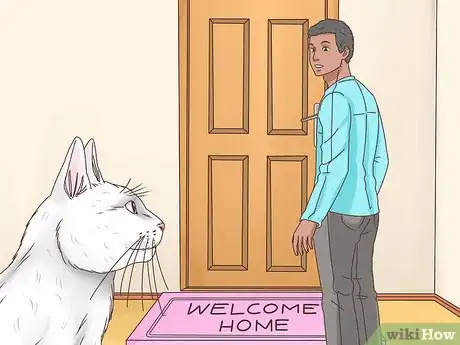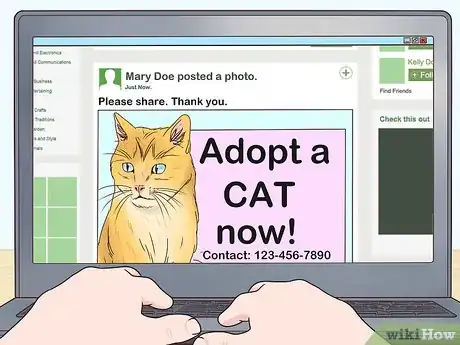This article was co-authored by Pippa Elliott, MRCVS. Dr. Elliott, BVMS, MRCVS is a veterinarian with over 30 years of experience in veterinary surgery and companion animal practice. She graduated from the University of Glasgow in 1987 with a degree in veterinary medicine and surgery. She has worked at the same animal clinic in her hometown for over 20 years.
This article has been viewed 25,145 times.
If you find yourself with a cat that you cannot keep, whether you have been followed home by a stray or you have a cat that you can no longer look after, you may need to find a happy, safe home for that animal. This can be a challenge that is fraught with problems because of the number of unwanted animals that fill shelters to overflowing. However, the animal needs, and deserves, your effort, as you may be its only advocate and its only chance for a loving and healthy home. When finding a home for a cat you need to focus on making good decisions when it comes to protecting that cat's welfare in order to find the cat an appropriate new home.
Steps
Dealing With a Stray Cat
-
1Verify that the cat is actually a stray. Of course it might be you are followed home by a stray and the cat really needs a home. However, you may have been followed home by a cat that is simply lost and needs to find its way home. If is important to determine which is the case before you move forward.
-
2Take the cat to the local vet to be scanned for a microchip. The vet can scan for the presence of a microchip that gives an id number for the cat. If the microchip is present, you can contact the database with the cat's number and reunite the lost kitty with its owners. It might be the cat got lost and has been living rough but is really a much loved family pet.[1]Advertisement
-
3Try to find the cat's owner. If the cat is not chipped and appears to be a stray, you should still take steps to find the owners. It is ideal to reunite it with its family but it is also important to look for the owners in order to comply with local regulations, which vary from place to place.
- Consider methods such as putting up posters describing the cat, contacting all vet clinics in the area and asking them to take the details, informing local shelters, and even asking the local radio to put a call out for the owners to come forward.
- After 7 days of real effort to find the owner, the cat is considered adoptable.
Finding a Cat a New Home
-
1Find a new owner among your acquaintances. Spread the word among friends, family and acquaintances that you have a cat in need of a home. Word of mouth recommendation is helpful as you are more likely to know something about the person who has come forward and be assured of their good character.[2]
-
2Consider contacting your local vet. They may know of someone looking for a cat. Also, they often know of people who have recently lost a cat and have space in their hearts to welcome a new feline friend.
-
3Advertise the cat. Put an ad in a local paper, online, or on the bulletin board of your local grocery store or place of worship. However, do not be naive and offer the cat to anyone who answers the ad. Prepare a list of questions to ask potential adopters so that you can judge whether the cat is going to a loving home.[3]
- A good question to ask is "What happened to your previous pet?" If their previous cat died in their sleep aged 20, that is a good answer. If the cat was killed in a traffic collision, then ask them what provision they have put in place to stop this happening again. If they surrendered their last cat to the shelter, then think carefully before handing the cat over and be sure that their circumstances have changed hugely and that they are prepared to put provisions in place, such as pet insurance, in order to meet all possible eventualities.[4]
- Avoid advertising a cat as "Free to a good home." Unfortunately, people who have been rejected by standard places to get a pet (such as from a shelter) may resort to getting pets from want ads. Some unscrupulous people who arrange dog fights will source cats from free ads to use as bait to get the dogs riled up, so don't risk this happening. At very least, ask for money to cover any veterinary expenses you have accrued or ask for a donation to the local shelter.
-
4Approach a shelter. Ask for guidance in finding the cat a home but also discuss the option of the cat going to the shelter.[5] Unfortunately shelters are full to bursting with unwanted pets, and they are often too full to take in more. If you do happen to find a shelter with a slot, be certain to find out if they have a no-kill policy. Some shelters are so overwhelmed that they have to euthanize a high percentage of those they take in. In some cases the kill rate is as high as 95%, so be sure you understand what you are signing the cat up for.[6]
-
5Find a specialty group that would be interested in helping you home the cat. If the cat is a pedigree, investigate a specific rehoming group. Groups exist dedicated to rehoming specific purebred cats. They will take the cat on or find a foster home, while they find a home among enthusiasts for the breed.
- Search online or ask your vet for details.
-
6Consider approaching charities specifically involved in rehoming cats. One such organization is called the Cats Protection League. They may be able to take the cat in. If they can't take the cat in, they may be able to offer one of their officials to do a home check on the person you find to adopt the cat.
Deciding to Rehome a Cat
-
1Decide whether you really need to rehome your cat. If the cat belongs to you, you need to take a close look at the reason why you need to rehome the cat. If you have any alternatives to getting rid of your cat, you should consider taking them.
- For example, many people believe it is unsafe to have a litter tray in the house when they are pregnant and therefore look to rehome a much loved feline companion. This fear arises from the (albeit slim) chance of picking up toxoplasma infection. However, scientists now believe the main route of infection is inadequately cooked meat rather than cat feces. If you wear disposable gloves and a mask, and clear the poop within 24 hours of it being produced the risk of infection is negligible. These simple measures could prevent the need for rehoming. If in doubt speak to your veterinarian who can advise you further on protecting your health and minimizing the risk of infection.
-
2Consider alternatives to rehoming. For example, a new baby in the house may have you feeling protective and worried about how the cat will react and if the cat will sleep on the baby and smother it. This is extremely unlikely to happen but if it's something that worries you, close the cat out of the room when the baby is alone. Take simple precautions, like keep the litter tray away from the baby and wash your hands after petting the cat.
- If you are moving abroad, be aware that a pet passport scheme operates widely now. Make inquiries at the embassy of the country you are moving to and ask them about the necessary protocol to import a cat into their country. Your vet can work closely with you to ensure the relevant vaccinations, blood tests, and paperwork is issued, and it's no big deal.
- It might be that you are moving within the country and just noticed your rental agreement has a 'no pets' clause. Before rehoming the cat, be honest with the landlord and ask if there is the possibility of making an exception. Some landlords put the clause on as a matter of routine, to protect themselves should a tenant have a destructive pet. Many landlords are open to a discussion about pets. It is especially helpful if you can put together a portfolio of documents that illustrate how well-behaved and well-cared for your pet it. A dossier containing records of vaccination certificates, vet checks, references from previous landlords, pictures of your pet doing cute things, like sleeping, can all go some way to convince a wavering landlord.
-
3Keep in mind the benefits of having a cat. Indeed, cats are hugely beneficial to a growing child. It's been shown that kids raised in a house with pets are less likely to develop asthma and allergies in later life.
- Having a pet can reduce stress in owners of all ages.
- They can also provide love and companionship to their owners, which can be especially important to people who live alone or are house bound.
-
4Place your cat in a great new home. Don't just abandon your cat and don't take it to a shelter unless you have exhausted all other possibilities. You have the responsibility to find it a safe and loving home where it can thrive. This may take some time and effort but you have that obligation to the cat.
Expert Q&A
-
QuestionHow do you get a cat to come out of hiding?
 Melissa Nelson, DVM, PhDDr. Nelson is a Veterinarian who specializes in Companion and Large Animal Medicine in Minnesota, where she has over 18 years of experience as a veterinarian in a rural clinic. She received her Doctor of Veterinary Medicine from the University of Minnesota in 1998.
Melissa Nelson, DVM, PhDDr. Nelson is a Veterinarian who specializes in Companion and Large Animal Medicine in Minnesota, where she has over 18 years of experience as a veterinarian in a rural clinic. She received her Doctor of Veterinary Medicine from the University of Minnesota in 1998.
Veterinarian If the cat is scared, it will take a lot of time for it to be comfortable around you and therefore it will take a while to come out of hiding. Using food (especially smelly, highly desirable food like tuna) is a good way to coax it out of hiding.
If the cat is scared, it will take a lot of time for it to be comfortable around you and therefore it will take a while to come out of hiding. Using food (especially smelly, highly desirable food like tuna) is a good way to coax it out of hiding. -
QuestionCan a cat get lost?
 Melissa Nelson, DVM, PhDDr. Nelson is a Veterinarian who specializes in Companion and Large Animal Medicine in Minnesota, where she has over 18 years of experience as a veterinarian in a rural clinic. She received her Doctor of Veterinary Medicine from the University of Minnesota in 1998.
Melissa Nelson, DVM, PhDDr. Nelson is a Veterinarian who specializes in Companion and Large Animal Medicine in Minnesota, where she has over 18 years of experience as a veterinarian in a rural clinic. She received her Doctor of Veterinary Medicine from the University of Minnesota in 1998.
Veterinarian Yes, cats can become lost especially if they are in unfamiliar territory. It is best to keep cats inside.
Yes, cats can become lost especially if they are in unfamiliar territory. It is best to keep cats inside. -
QuestionCan a cat get lost?
 Pippa Elliott, MRCVSDr. Elliott, BVMS, MRCVS is a veterinarian with over 30 years of experience in veterinary surgery and companion animal practice. She graduated from the University of Glasgow in 1987 with a degree in veterinary medicine and surgery. She has worked at the same animal clinic in her hometown for over 20 years.
Pippa Elliott, MRCVSDr. Elliott, BVMS, MRCVS is a veterinarian with over 30 years of experience in veterinary surgery and companion animal practice. She graduated from the University of Glasgow in 1987 with a degree in veterinary medicine and surgery. She has worked at the same animal clinic in her hometown for over 20 years.
Veterinarian Yes, cats can become disorientated and get lost. This is especially likely if the cat has never been outside before, and therefore has no reference landmarks to find their way back. Also, rain washes away vital scent landmarks, so escaping on a wet, dark night is worrisome.
Yes, cats can become disorientated and get lost. This is especially likely if the cat has never been outside before, and therefore has no reference landmarks to find their way back. Also, rain washes away vital scent landmarks, so escaping on a wet, dark night is worrisome.
References
- ↑ https://www.aaha.org/petmicrochiplookup
- ↑ http://blogs.rspca.org.uk/insights/2014/03/24/giving-up-a-pet/#.VmWZ7_mLTIU
- ↑ https://www.petfinder.com/pet-care/giving-up-your-pet/tips-finding-home-pet/
- ↑ https://www.petfinder.com/pet-care/giving-up-your-pet/tips-finding-home-pet/
- ↑ https://www.petfinder.com/helping-pets/feral-cats/helping-stray-abandoned-kittens/
- ↑ https://www.petfinder.com/pet-care/giving-up-your-pet/tips-finding-home-pet/
About This Article
To find a home for your cat, you can start by asking among friends, family, and acquaintances to see if anyone you know wants to adopt it. If you can’t find a new owner through word of mouth, try advertising your cat with an advert in a local paper, on a bulletin board, or online. You should also prepare a few questions to ask potential adopters to judge whether they’ll be a good fit for your cat, like “Why do you want to get a cat?” Alternatively, you can approach an animal shelter for help, but look for one with a no-kill policy, as many are overwhelmed with pets and often have to euthanize them. For more tips from our Veterinary co-author, including how to find a home for a stray cat, read on!








































































